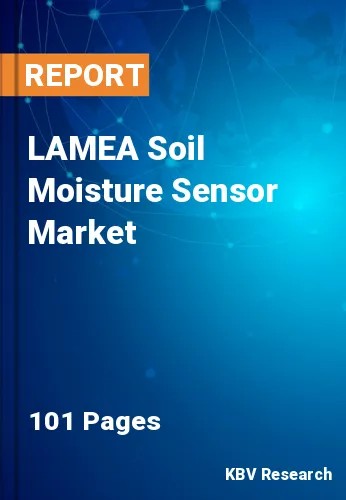The Latin America, Middle East and Africa Soil Moisture Sensor Market would witness market growth of 17.6% CAGR during the forecast period (2022-2028).
Connecting a soil moisture sensor to a conventional irrigation clock transforms it into an intelligent irrigation controller that inhibits irrigation cycles when the soil is already saturated, such as after a recent downpour. In order to prevent over-watering and the leakage of fertilizers or other chemicals into the soil, golf courses use soil moisture sensors to improve the efficiency of their irrigation systems.
Increasing adoption of these devices by the agricultural sector to improve farm output and minimize water usage is anticipated to fuel market expansion in the coming years. In addition, this device facilitates the avoidance of irrigation problems through regular monitoring, hence driving market expansion. The introduction of new technologies that enable homeowners in monitoring the soil moisture condition of their vegetable gardens, potted plants, and lawns is also anticipated to boost the market.
In the coming years, the rising demand for soil moisture sensors within the building and construction industry is also anticipated to boost market expansion. Before beginning a construction project, this device is highly preferred for detecting wetlands. The imminent demand for measuring water content on building sites is propelling market expansion.
Farmers in south-eastern Africa are willing to pay for soil moisture monitoring technologies, and this willingness to pay pertains to current market prices, to assist in determining whether or not it is economically feasible for a larger-scale adoption of monitoring tools in developing countries. The various approaches to a water management policy that can be used to address water scarcity are divided into two categories, namely supply-side instruments and demand-side instruments.
The Brazil market dominated the LAMEA Soil Moisture Sensor Market by Country in 2021, and would continue to be a dominant market till 2028; thereby, achieving a market value of $8,306.9 Thousands by 2028. The Argentina market is experiencing a CAGR of 18.2% during (2022 - 2028). Additionally, The UAE market would display a CAGR of 17.3% during (2022 - 2028).
Based on Application, the market is segmented into Agriculture, Construction & Mining, Residential, Forestry, Landscaping & Ground Care, Research Studies & Weather Forecasting, and Sports. Based on Connectivity, the market is segmented into Wired and Wireless. Based on Sensors, the market is segmented into Soil Water Potential Sensors (Tensiometers, Gypsum Blocks, and Granular Matrix Sensors) and Volumetric Soil Moisture Sensors (Capacitance Sensors, Time Domain Transmissometry (TDT) Sensors, and Probes). Based on countries, the market is segmented into Brazil, Argentina, UAE, Saudi Arabia, South Africa, Nigeria, and Rest of LAMEA.
Free Valuable Insights: The Global Soil Moisture Sensor Market is Predict to reach $464.2 Billion by 2028, at a CAGR of 13.7%
The market research report covers the analysis of key stake holders of the market. Key companies profiled in the report include Spectrum Technologies, Inc. (BAE Systems PLC), OTT HydroMet GmbH (Danaher Corporation), Acclima, Inc., Delta-T Devices Ltd., METER Group, Inc., SDEC France, Smartcultiva Corporation, Trellis, Inc., Vegetronix, Inc., and Stevens Water Monitoring Systems, Inc.
By Application
By Connectivity
By Sensors
By Country
Our team of dedicated experts can provide you with attractive expansion opportunities for your business.

